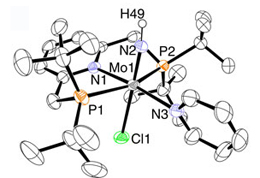Research Abstract
触媒的アンモニア生成反応におけるピンサー型配位子を持つ窒素架橋2核モリブデン錯体の特異な挙動
Unique behaviour of dinitrogen-bridged dimolybdenum complexes bearing pincer ligand towards catalytic formation of ammonia
2014年4月28日 Nature Communications 5 : 3737 doi: 10.1038/ncomms4737

温和な条件下で機能する効果的な窒素固定系を設計することは重要である。この目的のために、最近我々は、ピンサー型配位子を持つ窒素架橋2核モリブデン錯体を用いた触媒的アンモニア生成の例において、最高で23当量のアンモニアが生成することを報告した。今回我々は、密度関数理論計算によって、常温常圧下における窒素分子からの触媒的アンモニア生成における、この窒素架橋2核モリブデン錯体の特異的な触媒挙動の解明に成功した。2核モリブデン系と単核モリブデン系を比較することにより、触媒サイクル中で配位した窒素分子のプロトン化において窒素架橋2核モリブデン骨格が重要な役割を果たすことを明らかにした。
田中 宏昌1,2, 荒芝 和也3, 栗山 翔吾3, 笹田 瑛1,2, 中島 一成3, 吉澤 一成1,2 & 西林 仁昭3
- 九州大学先導物質化学研究所
- 京都大学触媒電池元素戦略研究拠点
- 東京大学大学院工学系研究科
It is vital to design effective nitrogen fixation systems that operate under mild conditions, and to this end we recently reported an example of the catalytic formation of ammonia using a dinitrogen-bridged dimolybdenum complex bearing a pincer ligand, where up to twenty three equivalents of ammonia were produced based on the catalyst. Here we study the origin of the catalytic behaviour of the dinitrogen-bridged dimolybdenum complex bearing the pincer ligand with density functional theory calculations, based on stoichiometric and catalytic formation of ammonia from molecular dinitrogen under ambient conditions. Comparison of di- and mono-molybdenum systems shows that the dinitrogen-bridged dimolybdenum core structure plays a critical role in the protonation of the coordinated molecular dinitrogen in the catalytic cycle.

